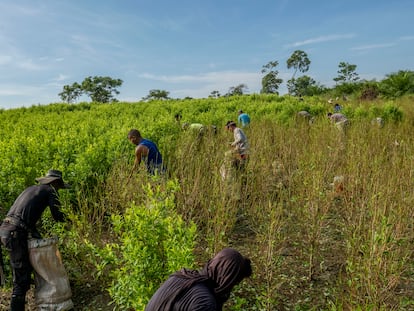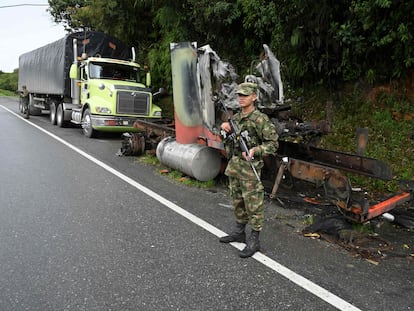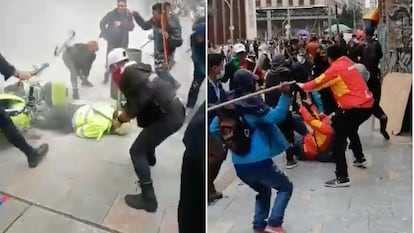Indigenous protest in Bogotá descends into clashes with police
At least 24 people were injured, including 11 law enforcement officers who were attacked with sticks and stones by demonstrators protesting their living conditions and the government’s lack of help
The tragedy of the Embera indigenous people, who have been living in settlements in Bogotá for two years, exploded on Wednesday like a pressure cooker. A group of them staged a street protest that quickly descended into a battle with law enforcement. Authorities said that some protesters began attacking public officials with sticks and stones before the police showed up. Both the Mayor’s Office and national government officials have condemned the violence, which left 24 people injured, including 11 police officers.
The Office of Mayor Claudia López said that the protesters blocked access to several buildings, including Edificio Avianca, a landmark skyscraper housing office space and located in the intersection of 14th Street and Seventh Avenue. Local officials said that law enforcement was sent out to “recover the area” after around 500 protesters blocked the entrance and acts of “unjustified violence” took place. Human rights organizations said instead that police officers stationed themselves outside the building despite the fact that, until that moment, the protest had been peaceful.
The history of the Embera people living in Bogotá goes back two years. Around 2,000 families arrived in the capital from different parts of the country at that time, fleeing the violence back home. For eight months, they survived inside a huge and unsanitary camp that occupied the National Park. Group leaders reached an agreement with the authorities in May to secure a safe passage back to their homes, or else be allowed to stay in shelters across the city. But protesters say the government has not lived up to its promises and that they continued to live in overcrowded conditions in the neighborhood of La Rioja. “We are vulnerable victims, we have no subsidies, we have nothing,” said Rosmira Campo, leader of the department of Risaralda.
La ausencia de diálogo siempre genera más violencia. Rechazo y condeno los actos vividos hoy en Bogotá. Varios miembros de la Fuerza Pública y civiles resultaron heridos. Nunca será protesta la agresión a un policía.
— Gustavo Petro (@petrogustavo) October 19, 2022
One of the campaign promises made by Gustavo Petro, a leftist who took office in August of this year, was to dismantle the Mobile Riot Squad (ESMAD), accused of violently repressing social protests. Sectors of the political right criticized Petro for this, viewing it as a lack of support for the country’s law enforcement. On Wednesday, the president tweeted that “the absence of dialogue always generates more violence. I reject and condemn the acts experienced today in Bogotá. Assaulting a police officer can never be viewed as a protest.”
The president of the Senate, Roy Barreras, considered a close aide of Petro, also repudiated the violence on social media. “An indigenous mob savagely beating a fallen police officer and a young female police aide on duty is a reprehensible and unacceptable act. That is NOT what resistance is about! NO to taking justice into one’s own hands! All forms of violence must be rejected by the Government!”
Que una turba d indígenas golpee salvajemente a un policial tirado en el suelo y a una joven mujer auxiliar bachiller q presta servicio es acto repudiable e inaceptable. La resistencia NO es eso! NO a la justicia por propia mano!Toda violencia debe ser rechazada por el Gobierno! pic.twitter.com/yM83akoDxQ
— Roy Barreras (@RoyBarreras) October 19, 2022
Bogotá Mayor Claudia López has demanded assistance from the central government in managing the crisis. “Bogotá is the only city and entity that has provided shelter and humanitarian aid to the Emberas for more than two years! It is inadmissible that our public servants have been attacked! The national government is neither preventing their displacement nor guaranteeing their safe return. Bogotá cannot go on alone like this!”
Tu suscripción se está usando en otro dispositivo
¿Quieres añadir otro usuario a tu suscripción?
Si continúas leyendo en este dispositivo, no se podrá leer en el otro.
FlechaTu suscripción se está usando en otro dispositivo y solo puedes acceder a EL PAÍS desde un dispositivo a la vez.
Si quieres compartir tu cuenta, cambia tu suscripción a la modalidad Premium, así podrás añadir otro usuario. Cada uno accederá con su propia cuenta de email, lo que os permitirá personalizar vuestra experiencia en EL PAÍS.
¿Tienes una suscripción de empresa? Accede aquí para contratar más cuentas.
En el caso de no saber quién está usando tu cuenta, te recomendamos cambiar tu contraseña aquí.
Si decides continuar compartiendo tu cuenta, este mensaje se mostrará en tu dispositivo y en el de la otra persona que está usando tu cuenta de forma indefinida, afectando a tu experiencia de lectura. Puedes consultar aquí los términos y condiciones de la suscripción digital.
More information

With no buyers, Colombian farmers are sitting on kilos of coca paste

The war on drugs: 50 years of death and failure
Archived In
Últimas noticias
Most viewed
- Oona Chaplin: ‘I told James Cameron that I was living in a treehouse and starting a permaculture project with a friend’
- Reinhard Genzel, Nobel laureate in physics: ‘One-minute videos will never give you the truth’
- Sinaloa Cartel war is taking its toll on Los Chapitos
- Why the price of coffee has skyrocketed: from Brazilian plantations to specialty coffee houses
- Silver prices are going crazy: This is what’s fueling the rally









































